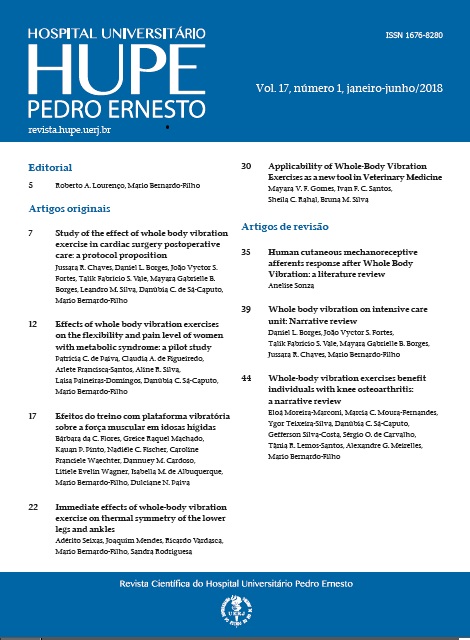Editorial
DOI:
https://doi.org/10.12957/rhupe.2018.39166Resumo
The scientific interest about the whole-body
vibrations exercise (WBVE) has grown along of the
time worldwide. WBVE is generated in an individual
in contact with the base of a vibratory platform.
Hence, mechanical vibration produced in the
platform is transmitted to the body of the individual.
This mechanical vibration is a physical agent that
is characterized by an oscillatory, harmonic and
deterministic motion; and biomechanical parameters,
as frequency and peak-to-peak displacement must be
well defined to the safety and feasibility of the WBVE
intervention.
Clinical and experimental studies have been
performed to try to improve the comprehension of
the effects of the WBVE. Publications have suggested
that biological effects would be associated with the
tonic vibration reflex and/or to the neuroendocrine
responses.
Several important clinical effects of the WBVE
have been described, such as (i) increase of the trunk
flexibility, strength and power muscle and bone
density, (ii) improvement of the quality of life, of
the balance and cognition, and (iii) decrease of both
pain and risk of falls. Therefore, WBVE can be used in
terms of fitness, disease treatment, in rehabilitation
program, and, in general termos, for the prevention
and promotion of health.
WBVE has been used as an intervention in various
populations, as (a) trained and untrained, (b) healthy
and unhealthy and (c) young, adult or elderly. Some
benefits have been reported. Animals (dog, horse) have
also been submitted to the WBVE.
In sports, improvements in the fitness have been
described in soccer players, divers, swimmers and
combat athletes, athletic throwers, dancers, and icehockey
players.
Several publications have shown investigations
with postmenopausal women evaluating the action of
WBVE related to the frailty and in the improvement
of the bone density and in reduction of the fall
risks. Individuals with metabolic syndrome, knee
osteoarthritis, chronic obstructive pulmonary disease,
diabetes and obesity have had benefits due to WBVE
intervention. The rehabilitation of subjects holding
some disability related to diseases, such as cerebral
palsy, osteogenesis imperfecta, spinal cord injury,
multiple sclerosis, Parkinson disease, stroke, when using
WBVE has revealed the relevance of this intervention.
In addition, studies about the applicability of wholebody
vibration therapy in intensive care patients have
also been reported.
Putting together all the previous considerations, it
is very important to highlight the importance of this
special issue of HUPE Journal to all Health Sciences
professionals that have common interest in the
treatment and prevention of diseases, as well as in the
promotion of the health.
The readers of this issue will have the opportunity
to verify, in the the original papers section, the
possibility of applications of the WBVE to cardiac
surgery postoperative care. In individuals with
metabolic syndrome it is shown the improvement
of the flexibility and the reduction of the pain level.
Considering the aging, a significant increase in the
muscle strength of the hip adductors and the knee
extensor muscles in elderly is also reported. Immediate
effects of WBVE on thermal symmetry of the lower
legs and ankles of healthy subjects are revealed. In
addition, the applicability of WBVE as a new tool in
Veterinary Medicine is shown. Besides all WBVE uses,
it is possible to point out that this clinical intervention
is safe, feasible, and cost-effective.
The human cutaneous mechanoreceptive afferents
response and the benefits of WBVE to individuals
with knee osteoarthritis are reviewed, together with
applications of the WBVE in Intensive Care Unit.


